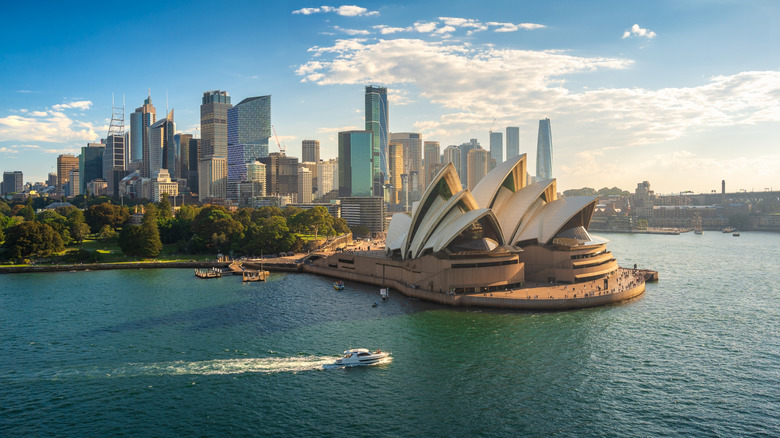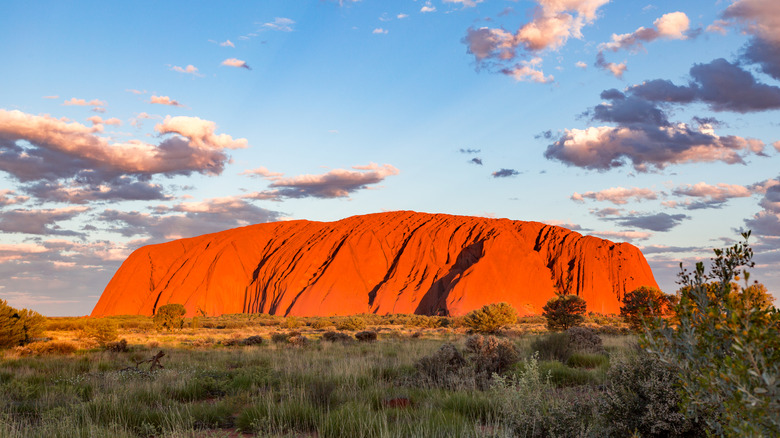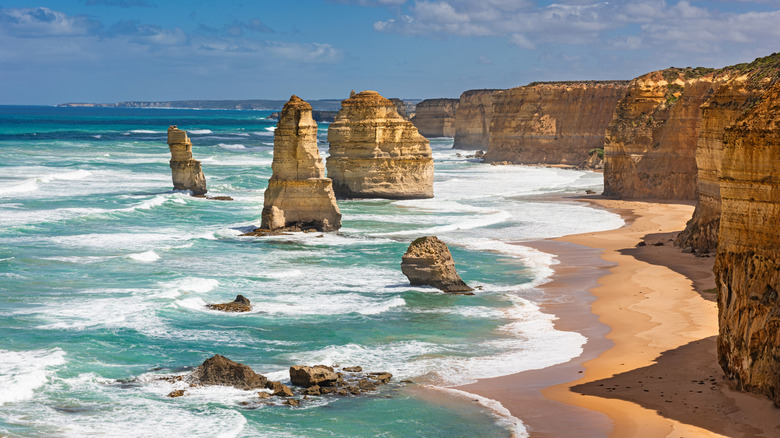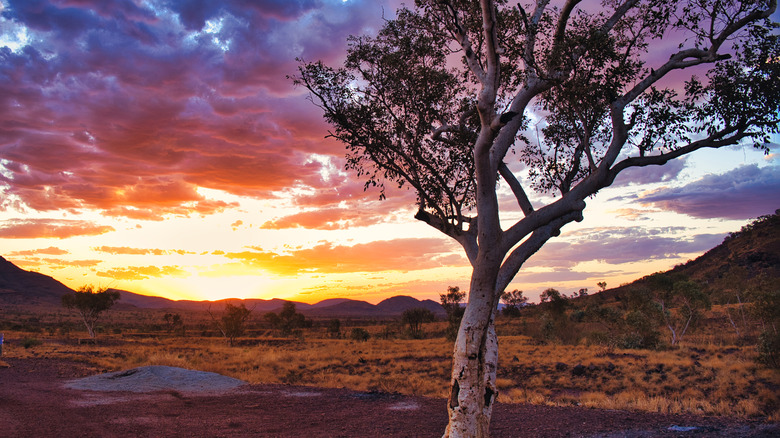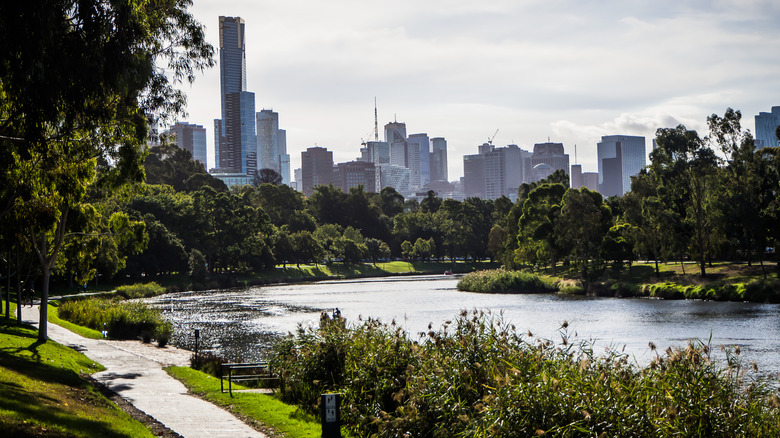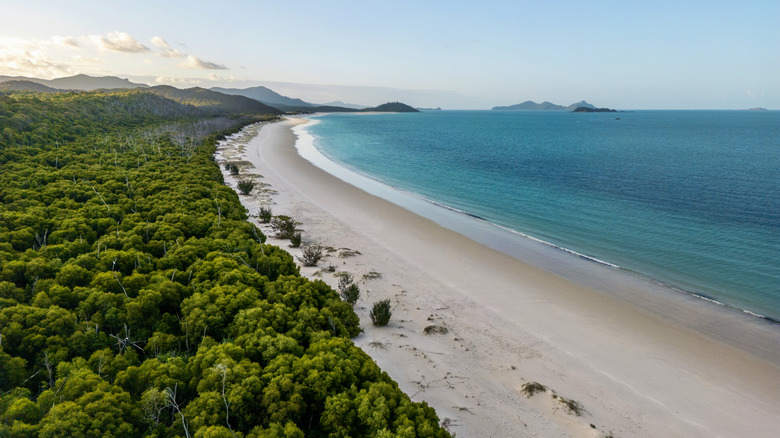Australia's Top 10 Scenic Destinations To Snap Stunning Pictures
With thousands of miles of coastline, energetic urban hubs, diverse wildlife, pristine beaches, and a wide range of beautiful landscapes, Australia is a country like no other. Sometimes compared to the U.S. in terms of size — its mainland is marginally smaller — it also has a thriving stockman or drover culture that's comparable to Western cowboys. Australia's beaches and reef breaks offer some of the world's best surfing, and you don't have to travel far to find amazing wine — especially shiraz. There's a bit of a sporting rivalry between the West Coast Eagles and Sydney Swans sports teams (in case catching a match is your thing), and there's endless art and culture to experience in the nation's buzzing cities like Sydney, Melbourne, Perth, Adelaide, Brisbane, and Gold Coast.
That said, whether you're a skilled photographer or simply like to snap a few photos on your phone, taking pictures during a trip to Australia is an affordable way to guarantee a fun reminder of your trip. After all, photos double as a great souvenir that you get to create yourself. Fortunately, Australia is brimming with amazing locations to focus your lens — from its bustling cities and vacation spots to more remote, historic, and expansive landscapes. Below, discover 10 scenic destinations Down Under that are perfect for taking great photos.
Sydney Harbour
Arguably Australia's most iconic scene, Sydney Harbour is home to the Sydney Opera House, with its instantly recognizable roofline, as well as the aptly named Sydney Harbour Bridge's distinctive steel arch. Phenomenal fireworks displays can be seen here on New Year's Eve, if you fancy making a special trip to capture the annual event. It's also a wonderful place to wander on a nice day, especially around Circular Quay, flanked by the opera house on one side and the bridge on the other. In between, you'll find the quay busy with coming and going tours and ferries — some of the best views are to be had from the water — and numerous restaurants and bars that offer great views from their tables. For a bite with a view, head to Cafe Sydney on the top floor of the heritage-listed Customs House, where you can take in a panoramic view of the harbor from the rooftop.
Across the harbor from Circular Quay, head to Copes Lookout for a vantage point that combines both the opera house and the Sydney Harbour Bridge, with the city skyline highlighted in between. The view becomes even more dramatic as the sun goes down and the lights begin to glow across the city.
A little further afield, head to Cremorne Point Wharf for a wide view of the whole harbor that still includes its most iconic highlights — another great way to capture the sunset. Cremorne Point boasts one of the most scenic walks you can find around the harbor, too, with lovely views of the shoreline and moored boats. Keep an eye out for the lush foliage of the somewhat hidden gem known as the Lex and Ruby Graham Gardens.
Great Barrier Reef and the Whitsunday Islands
One of Australia's most vital and beautiful regions graces the northern coastline of Queensland, located in the northeast part of the country. The Great Barrier Reef is so huge that it comprises about 10% of the entire planet's coral reef systems. It consists of around 3,000 reefs and hundreds of tropical islands with endlessly photo-worthy beaches. Of course, one of the best ways to take in this marine wonderland is via a boat cruise, of which there are many to choose from, ranging from a few hours to full-day jaunts.
Red Cat Adventures, for example, combines sightseeing with swimming and snorkeling around the Whitsunday Islands. If you have the ability to take underwater photos, this is the spot for you. Peep a few of the reef's more than 1,600 species of fish — including the beloved clownfish, plus sea turtles, manta rays, and even sharks. Getting up-close is key to capturing the color and detail of coral and fish. That said, nothing beats a view from the air if you crave an overview of this vast seascape. Helicopter tours, some of which combine itineraries with cruises, are another amazing way to take in this ocean ecosystem.
There are only a few all-inclusive resorts directly on the Great Barrier Reef, and they're among the world's most luxurious. Some of the most intimate are also the best for uninterrupted views. This includes everything from Green Island Eco Resort to Bedarra Island Resort and the ultra-remote Haggerstone Island Resort. The latter has only five villas, making it feel like you have the whole place to yourself.
Uluru-Kata Tjuta National Park
While it may be known as one of the world's most dangerous parks due to the intense desert heat, Uluru-Kata Tjuta National Park is a sacred, stunning natural landscape. It's a bit of a trek to get there, as it's about 30 hours by car from Sydney — amazing if you're a fan of road trips with plenty of photo ops along the way. However, you can also fly into Ayers Rock/Connellan Airport in Yulara, which has connections to Melbourne, Sydney, Adelaide, and Cairns. A flight will cut your travel time down to around three hours, and it's also an opportunity to take in this spectacular landscape from the air.
Situated in the southwest corner of the Northern Territory, Uluru-Kata Tjuta National Park sits pretty close to the middle of Australia. Its main features are enormous red-rock geological formations, Uluru and Kata Tjuta, which the Aboriginal Anangu people believe were formed by their ancestors and still hold incredible significance in their culture. UNESCO designated the region a World Heritage Site twice over, first in 1987 and then in 1994, to recognize both its physical geography and its cultural richness. Uluru, in particular — a huge, oval-shaped rock — is one of the most photographed natural monuments in the country.
Capturing the stunningly dark sky, the glowing rock at sunset, and the surrounding landscape are a treat for photographers. Remember to pack a good lens-cleaning cloth, as sand tends to blow around. And as a protected site, there are some protocols in place to preserve Uluru's sacredness, so stick to the walking paths and respect places where photos are prohibited. Astonishing views of the rock can be had at both sunrise and sunset, when it's glorious viewed from afar against the changing sky.
Blue Mountains National Park
One of the best things about the Blue Mountains is that they're a very easy jaunt from Sydney, which makes them perfect for a day trip, a long weekend, or an extended outdoors trek. Adventurers flock to these Australian mountains for thrilling hikes and pretty waterfalls, not to mention some adorable small towns with plenty of artsy vibes. From Sydney, you can reach Blue Mountains National Park via a 40-mile drive, and you'll be spoiled for choice when it comes to places to stay. Backpackers can camp in the park or head to budget-friendly hostels like the YHA Blue Mountains Katoomba or the Flying Fox. Alternatively, head to one of the area's towns — like Katoomba or Leura, a storybook town with cherry blossoms — to walk through historic gardens and along streets lined with quaint shops. To capture some of the region's famous waterfalls, head to Sylvia Falls, near the town of Wentworth Falls, or the gorgeous layers of Terrace Falls near Hazelbrook.
The highlights of this region are, of course, of the natural variety, and the Three Sisters near Katoomba don't disappoint. Visit Echo Point for amazing photo opportunities toward the sandstone formation and the surrounding Jamison Valley. Or, for aerial views that can't be matched, hop aboard a scenic cable car or Scenic Skyway ride at Scenic World, which convey you up a mountain or over the valley. The attraction is also home to the steepest passenger railway on Earth — it's even in the Guinness Book of World Records — and a beautiful elevated boardwalk through the rainforest.
The Great Ocean Road
A 151-mile scenic coastal road in Victoria, the state at the southeastern tip of the Australian mainland, promises a coastal road trip that's definitely one to write home about. The Great Ocean Road, which follows route B100, is a gorgeous drive with views over the Bass Strait and the Southern Ocean. Among some of the best stops to make on your trip along Australia's Great Ocean Road, you won't want to miss the beautiful Bell's Beach, which sits near Torquay — a great first stop if you're starting your journey from there and heading westward. A great vantage point is from above, capturing the gentle curve of the sand, greenery, and small bluffs.
Just a little further down the road, head to Point Addis Marine National Park for remarkable views from the peninsula, or climb atop Split Point Lighthouse for an amazing perspective from above. The Great Ocean Road is chock full of natural beauty, friendly towns, and endless ocean vistas, so it's the sort of place where you'll be happy you have your camera. Perhaps the most iconic area along this route is known as the Twelve Apostles, which features sheer cliffs down to breaking surf, with a number of freestanding rock formations in the water that easily lend themselves to gorgeous photos. It can get very busy at some of the best-known scenic spots along this route, so planning your trip for an off-peak time may help you avoid the crowds. The best weather for the journey is between March and April, when it's cooler than mid-summer but not quite winter-like. Try visiting major attractions like the Twelve Apostles either early or late in the day.
Lord Howe Island
A little more than 370 miles off the coast of eastern mainland Australia, Lord Howe Island is a remote destination worth the extra planning it requires to visit. Only 400 tourists are allowed on the island at any one time, a method of preservation that works well for both the natural environment and also the visitor experience. "It's what is not here that provides that experience — that is why it's so unique," local hospitality proprietor Lisa Makiiti told CNN Travel. Makiiti runs a small lodge called Bowker Beach House, which offers an exceedingly private accommodation experience so that you feel like you practically have the entire island to yourself. Daily flights from Sydney take less than two hours.
Lord Howe Island is part of a small group of islands that makes up a UNESCO World Heritage Site, recognized for fantastic volcanic topography with steep cliffs, endless views of the Tasman Sea, and expansive coral reefs. It's perfect for exploring on land or via the water, and for activities like hiking, biking, snorkeling, sailing, and surfing. One of the best hiking trails for panoramic views is a 3-mile loop that leads you via Neds Beach, Malabar Hill, and Kims Lookout. Wildlife photography is a treat here, as the island provides a breeding ground for 14 seabird species. Paddle out on a kayak to get amazing views of the mountains and surrounding crystal-clear waters.
The Pilbara
In the north-central portion of Western Australia, the Pilbara is a testament to richly layered cultural traditions that have made a mark — quite literally — on this expansive, arid landscape. The residential population hovers around 60,000 people in an area that's even larger in square miles than California, and most residents live in the city of Newman. The Pilbara's dramatic, red-rock landscape sets a striking scene in a world of contrasts. Its coastline features pristine white sand beaches and islands, including a ghost town called Cossack that holds the distinction of being the first colonial settlement in Western Australia. Meanwhile, the Pilbara's inland expanses glow red with mineral deposits — the shire is also an industrial mining hub for crude oil, salt, iron ore, and natural gas — and some of its rock faces have been a canvas for pictographic carvings for tens of thousands of years.
For amazing photographs of some of the most dramatic rock formations and gloriously dark skies, head to Karijini National Park — situated about a two-hour drive northwest of Newman. Its canyons and terrain are more than 2 billion years old, and it's an amazing place to spot iconic Australian wildlife like kangaroos, wallabies, goannas, and more. Look for giant termite mounds, too, which add a unique feature to the landscape.
Margaret River
Located on a far southwestern point in Western Australia, about a three-hour drive south of Perth, the Margaret River Region is a phenomenal oceanside destination with west coast vibes and a thriving wine scene. Known by the Aboriginal name Wadandi Boodja, this area is shaped by the ocean, making it a prime place to check out some of the best beaches in all of Australia. The Margaret River area is also home to the 76.5-mile Cape to Cape Track, an eminently scenic hiking route that connects Cape Naturaliste and Cape Leeuwin. So, when it comes to postcard-worthy vistas, a great snapshot won't be hard to find.
Two go-to spots for iconic local photos are the lighthouses at Cape Naturaliste and Cape Leeuwin. Hamelin Bay also boasts pearlescent sandy shorelines, or you can head inland just a bit to the Boranup Karri Forest for views of karri trees — a variety of eucalyptus — that reach nearly 200 feet tall in some cases. An engineering marvel awaits at the Busselton Jetty, which was built in 1865 and stretches well over a mile into the water. Also, make sure you head to Leeuwin-Naturaliste National Park, near Cape Naturaliste, for beautiful views at sunset over Sugarloaf Rock. In this vineyard-dappled region, don't miss winding down with a tasting at one of dozens of wineries, which often make for great settings for photos, too. Vasse Felix is the area's first, founded seven decades ago, and Howard Park is a go-to for contemporary refinement.
Cradle Mountain-Lake St. Clair National Park, Tasmania
Seeking gorgeous coastal views, beautiful mountains, varied ecosystems, and unique wildlife all in one place? Look no further than Tasmania, a picture-perfect island where you can take a deep breath of the cleanest air on Earth. Its remote Cape Grim, sometimes referred to as the "Edge of the World," is home to an air pollution monitoring station that measures gases and fumes — like from exhaust — and, thanks to strong winds rushing up from Antarctica, it's some of the least polluted air in the world. Tasmania is also where you'll find an incredible array of nature and wilderness to explore across 19 national parks that cover, along with other protected sites and nature reserves, a whopping 40% of the island. You won't be at a loss for framing a great photo here.
Head to Cradle Mountain-Lake St. Clair National Park for a diverse experience of Tasmania's gorgeous, craggy, alpine terrain. It's an outdoor-lover's paradise and also a haven for photographers, as its more southerly position away from equator means that, in comparison to the Great Barrier Reef, for example, the light is a little paler and creates a lovely atmosphere for landscape photos. Additionally, head to Dove Lake for stunning views of Cradle Mountain over the water. The winding pathways and boardwalks throughout the park also offer an attractive focal point through the trees and meadows. Weather can be changeable, and it's best for hiking during the summer and early autumn (November to March), or for snow-capped mountain views in the winter (June to August).
Royal Botanic Gardens Victoria - Melbourne
Naturally, scenic locations are often far away from cities, where you'll find myriad panoramic vistas of ocean, desert, or mountains. But urban hubs, with their architectural elements, energetic streets, harbors, and historic landmarks, are also wonderful places to snap great pictures. And don't forget gardens! The Royal Botanic Gardens Victoria – Melbourne is an easy-to-reach attraction where beautiful flora converges with views of the city. Free to visit and open daily from 7:30 a.m. to 7:30 p.m., you can take a picnic and spend hours wandering, go for a morning jog, or visit for just a little while before heading to a nearby restaurant, like Yarra Botanica, for dinner.
The Royal Botanic Gardens Victoria is a well-established feature of central Melbourne, founded in 1846 and boasting more than 8,500 plant species across 94 verdant acres. It's a perfect destination for macro photography fans who love capturing the delicate details of tropical flora, roses, herbs, cacti, and more. Nearly two dozen of the garden's Living Collections provide glimpses of camellias, perennial border plants, rare Australian species, endemic New Zealand varieties, and many more. For a typical visit, you won't need a permit to take photos in the garden, as long as the images aren't intended for research, events, or commercial purposes. Otherwise, you'll have to contact the gardens directly to secure the right permissions. And, as tempting as it may be, drones aren't allowed at the Royal Botanic Gardens Victoria. Thankfully, you'll be able to find plenty of beautiful vantage points from the park's many paths and groves.
Methodology
It's impossible to cover every area of this vast, diverse, and historic continent, but this list of 10 great destinations is most useful as a starting point for first-time visitors. To land on our top picks, we consulted national and regional tourism sites like Australia.com, Sydney.com, SydneyExpert.com, MargaretRiver.com, AustraliasNorthwest.com, Uluru.gov.au, VisitNSW.com, VisitMelbourne.com, DiscoverTasmania.com.au, VisitGreatOceanRoad.org.au, and LordHoweIsland.info for information about different states, parks, communities.
Some information and data about specific places we also gleaned from AboutAustralia.com, WorldPopulationrReview.com, Britannica.com, Great Barrier Reef Marine Park Authority, UNESCO, TrailsWA.com.au, and AtlasObscura.com. In terms of photography, we relied on insights from photographers who have shared tips on OurBigJourney.com, BestoftheBlueMountains.com, and PhotoBasecamp.com. Finally, we also relied on imagery submitted — along with reviews and ratings — by visitors, via sites like TripAdvisor, Google, Reddit, and AllTrails.
